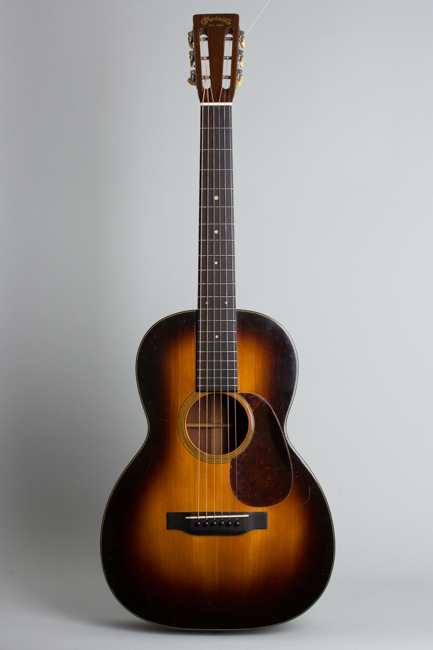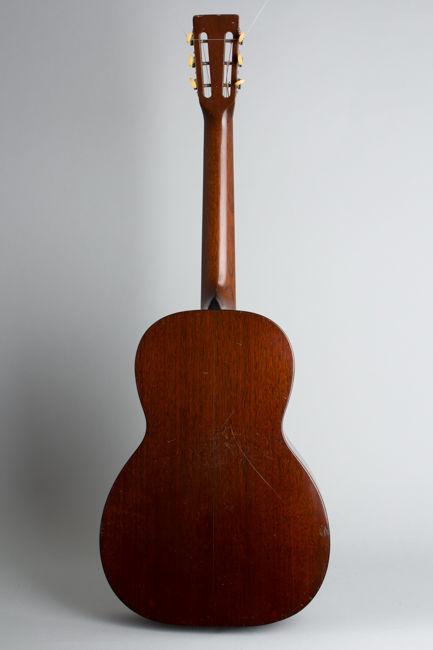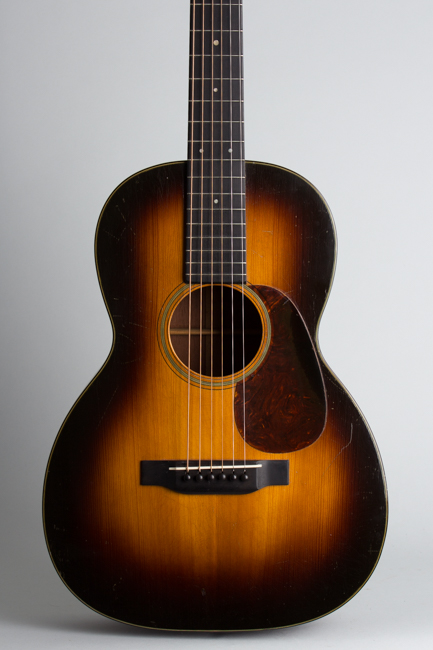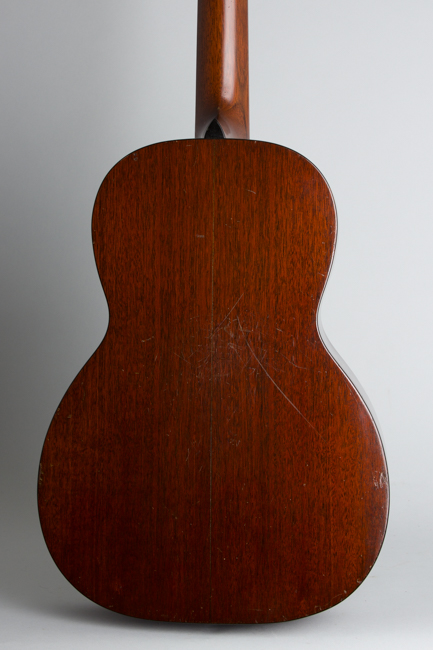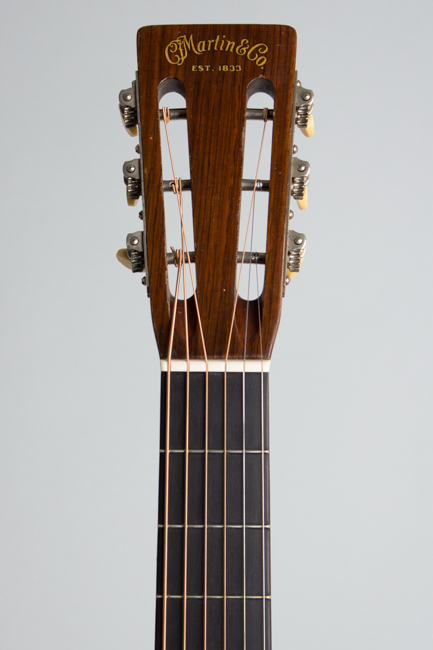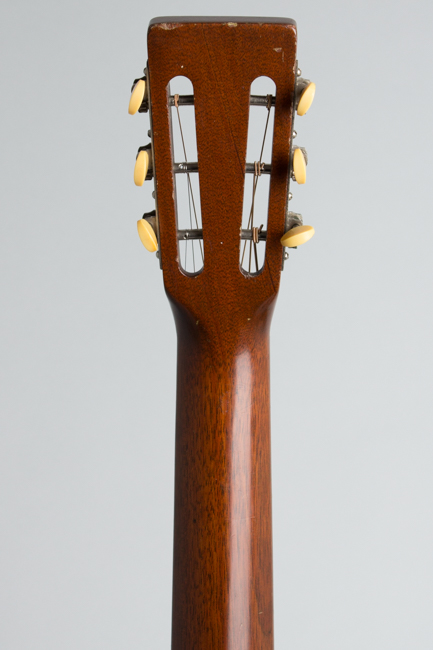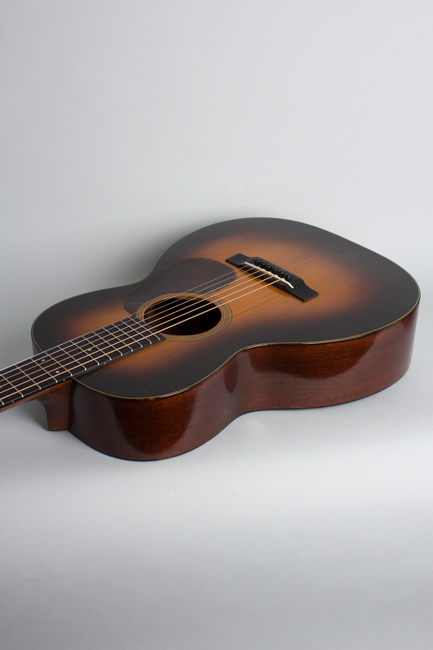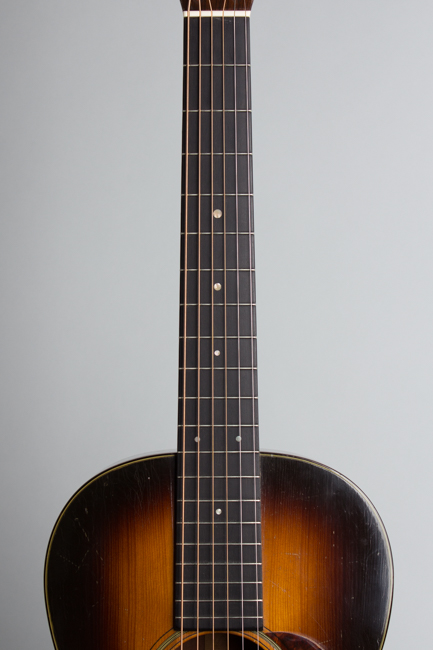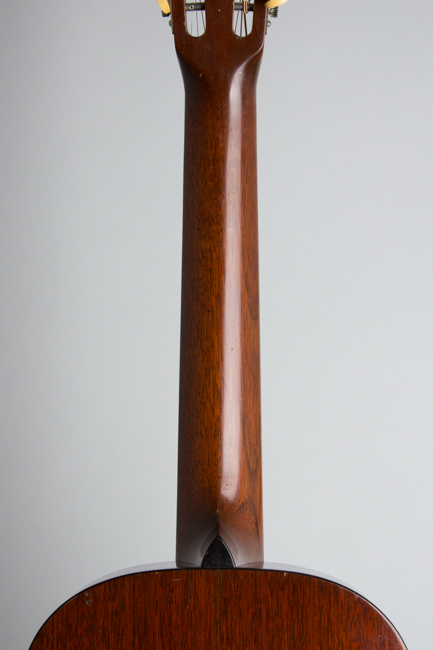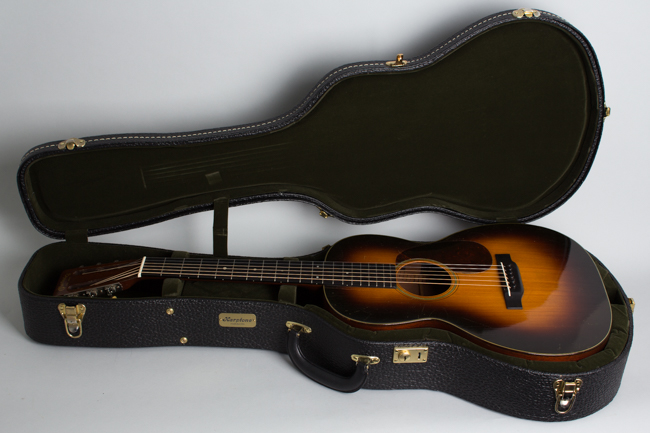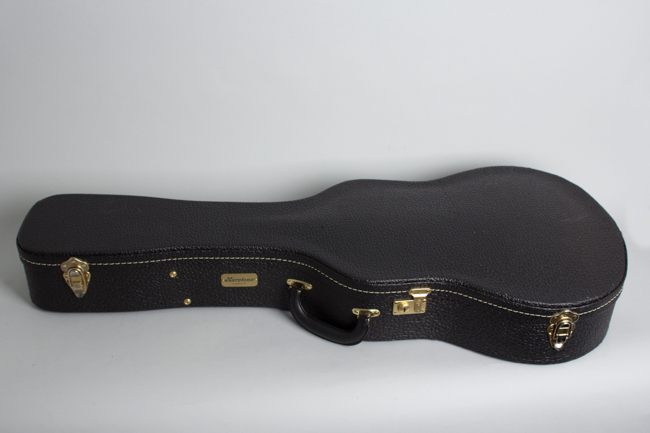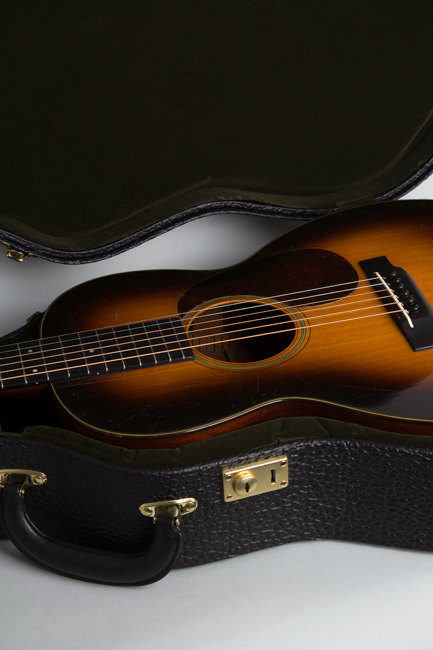C. F. Martin 00-18H Conversion Flat Top Acoustic Guitar (1937)
This item has been sold.
Item # 9942
Prices subject to change without notice.
C. F. Martin 00-18H Conversion Model Flat Top Acoustic Guitar (1937), made in Nazareth, PA, serial # 65836, sunburst top, natural back and sides finish, mahogany back, sides and neck, spruce top and ebony fingerboard, black tolex hard shell case.
This lovely shade-top 00-18 is a superbly professional conversion from the original Hawaiian mode, including a neck set, fretwork with bar frets, and the original bridge carefully re-worked with a properly angled saddle. All work is of the highest level and this is a truly superb playing and sounding instrument. This "shade top" 00-18H is also a rare guitar with a distinct character.
While the Hawaiian guitar was generally well on the march to electrification in 1937, most major companies were still building acoustic flat tops specifically for lap players. This one dates to early in the year, one of 128 issued in the largest production run the model enjoyed. Only 255 00-18H instruments were built in total, and many if not most would have featured a natural top finish instead of the dramatic sunburst seen here. By this time the "regular" 00-18 was only built as a 14-fret model, this Hawaiian variant was the only 12-fret version available.
The 00-18H was a fairly modest instrument, the only mahogany Hawaiian-style model in the company's mid-30's line, priced well under the rosewood-and-pearl 00-40H. It was primarily intended for students, as teaching the Hawaiian guitar was big business in the 1930s. Like all Style 18 models it is built with mahogany back and sides and a spruce top but still maintain the same workmanship standards as the highest-grade rosewood instruments.
The trim is simple with celluloid binding on the body, multiple W/B/W soundhole rings and graduated pearl dot inlay on the unbound ebony fingerboard. The guitar has "modern'' features like the belly bridge and tortoise celluloid pickguard not seen on 1920s 12-fret guitars. The tuners are Grover strip units with celluloid buttons that are specific to this era.
This is a truly excellent-playing instrument with a superb sound. Martin's pre-war Hawaiian guitars were braced just slightly heavier than other models, but still to prewar standards. They tops are sturdier than their 1920's ancestors and are of course designed for steel strings. They tend to have somewhat more punch than their 14-fret 1930s Spanish cousins when driven hard, but are still quite responsive. This is just a super sharp-looking prewar Martin with a great vibe, distinctive both visually and sonically.
Overall length is 38 1/2 in. (97.8 cm.), 14 1/4 in. (36.2 cm.) wide at lower bout, and 4 1/8 in. (10.5 cm.) in depth at side, taken at the end block. Scale length is 24 3/4 in. (629 mm.). Width of nut is 1 7/8 in. (48 mm.).
This guitar shows some minor wear overall but is structurally excellent. The finish remains original with some chips, scratches and dings but no heavy wear. The neck has been re-set, and the once-straight saddle slot on the original full-height bridge has been filled and re-routed in a compensated position. The nut is a high quality bone replacement at the correct height for standard playing. There is a small area of touch-up at the base of the headstock veneer adjacent to the nut. The original bar frets were ground flush with the face of the fingerboard at the factory; they have been carefully shimmed underneath and crowned for Spanish-style play.
There are tiny marks on sides of the headstock from the original strip tuners having been flipped to an upside-down position at some point during its life as a Hawaiian guitar. Tt\here is a small repaired punch in the upper bout treble side rim, glued up but not cleated on the inside. From the outside, it has been carefully touched up to be barely noticeable. On the lower bout bass side rim, a short one inch crack has been neatly sealed. There are no other cracks on the instrument. The original small maple bridge plate is in excellent condition, with a little bit of glue residue presumably left from the regluing of a carefully glued crack on the bridge along the bridge pin holes.
This guitar is an excellent player, the conversion from Hawaiian to standard format has been done to the highest standards resulting in a smaller-body 12-fret Martin with a lot of punch that can be pushed harder than many similar guitars. It is also lovely to look at, with a beautiful dark sunburst top that is vibrant and unfaded. The guitar is housed in a high-quality modern HSC. Excellent Condition.
This lovely shade-top 00-18 is a superbly professional conversion from the original Hawaiian mode, including a neck set, fretwork with bar frets, and the original bridge carefully re-worked with a properly angled saddle. All work is of the highest level and this is a truly superb playing and sounding instrument. This "shade top" 00-18H is also a rare guitar with a distinct character.
While the Hawaiian guitar was generally well on the march to electrification in 1937, most major companies were still building acoustic flat tops specifically for lap players. This one dates to early in the year, one of 128 issued in the largest production run the model enjoyed. Only 255 00-18H instruments were built in total, and many if not most would have featured a natural top finish instead of the dramatic sunburst seen here. By this time the "regular" 00-18 was only built as a 14-fret model, this Hawaiian variant was the only 12-fret version available.
The 00-18H was a fairly modest instrument, the only mahogany Hawaiian-style model in the company's mid-30's line, priced well under the rosewood-and-pearl 00-40H. It was primarily intended for students, as teaching the Hawaiian guitar was big business in the 1930s. Like all Style 18 models it is built with mahogany back and sides and a spruce top but still maintain the same workmanship standards as the highest-grade rosewood instruments.
The trim is simple with celluloid binding on the body, multiple W/B/W soundhole rings and graduated pearl dot inlay on the unbound ebony fingerboard. The guitar has "modern'' features like the belly bridge and tortoise celluloid pickguard not seen on 1920s 12-fret guitars. The tuners are Grover strip units with celluloid buttons that are specific to this era.
This is a truly excellent-playing instrument with a superb sound. Martin's pre-war Hawaiian guitars were braced just slightly heavier than other models, but still to prewar standards. They tops are sturdier than their 1920's ancestors and are of course designed for steel strings. They tend to have somewhat more punch than their 14-fret 1930s Spanish cousins when driven hard, but are still quite responsive. This is just a super sharp-looking prewar Martin with a great vibe, distinctive both visually and sonically.
Overall length is 38 1/2 in. (97.8 cm.), 14 1/4 in. (36.2 cm.) wide at lower bout, and 4 1/8 in. (10.5 cm.) in depth at side, taken at the end block. Scale length is 24 3/4 in. (629 mm.). Width of nut is 1 7/8 in. (48 mm.).
This guitar shows some minor wear overall but is structurally excellent. The finish remains original with some chips, scratches and dings but no heavy wear. The neck has been re-set, and the once-straight saddle slot on the original full-height bridge has been filled and re-routed in a compensated position. The nut is a high quality bone replacement at the correct height for standard playing. There is a small area of touch-up at the base of the headstock veneer adjacent to the nut. The original bar frets were ground flush with the face of the fingerboard at the factory; they have been carefully shimmed underneath and crowned for Spanish-style play.
There are tiny marks on sides of the headstock from the original strip tuners having been flipped to an upside-down position at some point during its life as a Hawaiian guitar. Tt\here is a small repaired punch in the upper bout treble side rim, glued up but not cleated on the inside. From the outside, it has been carefully touched up to be barely noticeable. On the lower bout bass side rim, a short one inch crack has been neatly sealed. There are no other cracks on the instrument. The original small maple bridge plate is in excellent condition, with a little bit of glue residue presumably left from the regluing of a carefully glued crack on the bridge along the bridge pin holes.
This guitar is an excellent player, the conversion from Hawaiian to standard format has been done to the highest standards resulting in a smaller-body 12-fret Martin with a lot of punch that can be pushed harder than many similar guitars. It is also lovely to look at, with a beautiful dark sunburst top that is vibrant and unfaded. The guitar is housed in a high-quality modern HSC. Excellent Condition.
